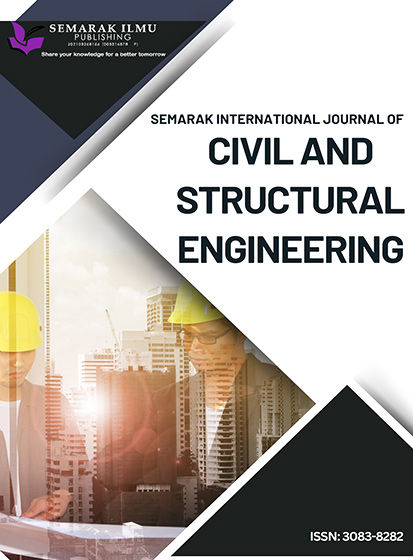The Use of Monofilament Fibre Reinforcement Concrete in Improving Soil-Cement Columns
DOI:
https://doi.org/10.37934/sijcse.3.1.113Keywords:
Fibre-reinforced concrete, soil-cement columns, ground improvement, industrial waste, management, environmental pollutionAbstract
This study examines the improvement of soil characteristics through the incorporation of fibre-reinforced concrete (FRC) into soil-cement columns. The study involves a detailed examination of the physical and mechanical properties of soil, highlighting the influence of different compositions of FRC and cement and clay combinations on soil stability. The approach comprises two categories of tests: physical property testing to ascertain the natural characteristics and behaviour of soil, and mechanical property testing, which primarily evaluates the impact of FRC on soil-cement columns. The shear box test and the unconfined compression test (UCT) were performed to achieve these aims. A series of mixtures was conducted to examine the behaviour of the FRC-cement column with varying cement and fibre contents. This study employs two stabilisers: cement and FRC. Cement compositions of 10%, 15%, 20%, and 25% were utilised. Each mixture was subsequently amalgamated with differing proportions of FRC to enhance the composite's characteristics: the 90% clay and 10% cement mixture was integrated with 0.5% FRC; the 85% clay and 15% cement mixture with 1.0% FRC; the 80% clay and 20% cement mixture with 1.5% FRC; and the 75% clay and 25% cement mixture with 2.0% FRC. The shear box test and UCT test were performed on the cement column samples both with and without FRC inclusions after 14 and 28 days of cure. The findings demonstrated that the incorporation of FRC in both uncemented and cement-stabilised soil enhanced the unconfined compressive strength and axial strain at failure, transforming the brittle behaviour of cement-stabilised soil into a more ductile behaviour. The UCT test indicates that a mixture of 20% cement and 1.5% FRC can enhance compression strength to 3005.00 kPa after a 28-day curing period. The shear strength similarly increased, with the identical mixture yielding a measured value of 2065.3 kPa after a 28-day curing time. The mechanical properties of the soil-cement-fibre combinations were enhanced through the utilisation of FRC.













